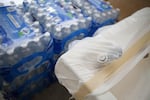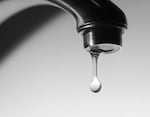
A covered drinking fountain sits next to cases of bottled water at Llewellyn Elementary in Sellwood, in Southeast Portland.
Bradley W. Parks / OPB
Oregon’s largest school district has shut off the drinking water on every campus after tests showed elevated lead levels at two schools.
Since Portland Public Schools revealed the findings, questions about the health risks of lead exposure as well as what the school district will do to combat the problem have swirled.

Creston School in Southeast Portland on Saturday, May 28, 2016.
Bradley W. Parks / OPB
How Did We Get Here?
On May 26, 2016, PPS announced the discovery of lead levels above Environmental Protection Agency benchmarks in two of its schools: Creston and Rose City Park. The district shut off drinking water at all of its schools as a precaution.
However, emails obtained by OPB indicated the district knew about the issue as early as 2012 after a Rigler School parent raised the issue.
Portland school officials, including Superintendent Carole Smith, met with parents and community members on Tuesday, May 31, to address questions and concerns. That public meeting, the first since the findings at Creston and Rose City Park, often grew tense.
"School board, you need to act. And Carole Smith, you need to go," parent Mike Southern told the administrators.
What Are The Health Risks Of Lead?
Lead can interfere with the production of red blood cells that carry oxygen to all parts of the body.
The greatest risk of lead exposure is to infants, young children and pregnant women. Scientists have linked the effects of lead on the brain with lowered IQ in children and other developmental problems.

Portland Water Bureau's Mt. Tabor Reservoir No. 5
Michael Clapp / OPB
How Does Lead Get Into The Water Supply?
Most lead leaches into the water through lead solder, not the pipes themselves. Lead solder was commonly used in homes built or plumbed with copper pipes before 1985.
Lead can also be found in brass plumbing fixtures and components. When corrosive water stands for hours in plumbing systems that contain lead, lead dissolves into the water.
The Portland Water Bureau, which provides water to about 1 million Oregonians, adds sodium hydroxide to increase the pH of drinking water, making it less corrosive.
There Are Ways To Prevent Or Reduce Lead In Water
Filters can help reduce lead in the water by more than 90 percent.
If the water coming out of a faucet has not been used for several hours, run each tap for 30 seconds to two minutes or until the water becomes colder. Cook and make baby formula with that cold water.

Many communities in the Northwest have discovered high lead levels in their water.
Maegan Tintari / Flickr
Water Is Not The Only Source For Lead Exposure
In Portland, the most common source of lead is from lead-based paint. Though the use of lead-based paint for homes, toys and furniture was banned in the late 1970s, many older homes still contain it.
In a study of older homes in North, Northeast and Southeast Portland, 71 percent had lead dust levels that exceeded federal standards.
Other sources of lead include: dust, soil and other household objects like toys, cosmetics and pottery.
How Can Homeowners Test Their Water Supplies For Lead?
The Portland Public Schools situation has a lot of homeowners wondering about their own water supplies. Many water agencies offer free lead test kits. For more information, call the Multnomah County "lead line" at 503-988-4000 or visit their website.

In this May 31, 2016 photo, Portland officials listen as parents voice objections to recent revelations of lead found in school drinking water. From left, Superintendent Carole Smith, Portland Public Schools Board of Directors Chair Tom Koehler, PPS Chief Operating Officer Tony Magliano and Portland-area State Representative Rob Nosse (standing).
Rob Manning / OPB
Where Does PPS Go From Here?
Portland Public Schools administrators say crews will spend the summer testing and repairing every water fountain and sink faucet in the district.
Smith, the superintendent, says she wants to form a community task force on drinking water. She also wants to hire outside investigators to examine recent and long-term lead problems in the district.